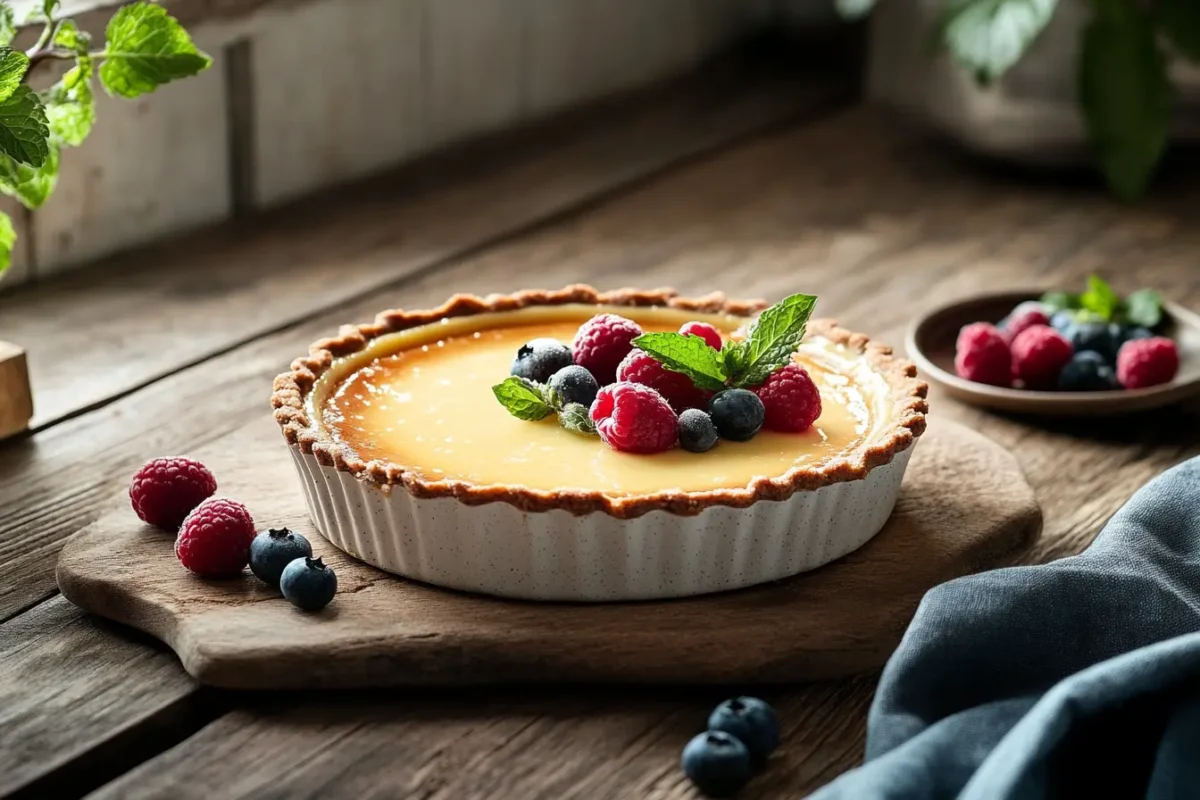Making crème brûlée is a culinary adventure. This decadent dessert, often served in ramekins with a satisfying caramelized sugar crust, doesn’t always require those traditional dishes. You might be wondering, “Can I make crème brûlée without ramekins?” The answer is yes! With some creativity and a few kitchen staples, you can recreate this classic treat without sacrificing its creamy texture or signature crackling top. For traditional recipes, check out this crème brûlée guide on Allrecipes.
In this article, we’ll dive into creative ways to make crème brûlée using everyday kitchen items, provide tips for ensuring perfect results, and share a step-by-step recipe. Whether you’re a seasoned baker or a dessert enthusiast, this guide will help you achieve custard perfection with whatever you’ve got at home.
Introduction to Crème Brûlée
What Is Crème Brûlée?
Crème brûlée, meaning “burnt cream” in French, is a rich custard dessert topped with a caramelized sugar crust. The smooth, creamy texture of the custard contrasts perfectly with the brittle topping, making it a favorite treat for special occasions. Traditionally, it’s baked in small, shallow dishes called ramekins, which help achieve even cooking and a perfect single-serving presentation.
The Traditional Role of Ramekins
Ramekins are small, oven-safe dishes designed for individual portions. They help maintain even heat distribution, ensuring the custard cooks uniformly. Their compact size also makes it easy to achieve the thin sugar topping that defines crème brûlée. However, ramekins aren’t the only option, and you can make this dessert just as delicious using alternatives.
Why Look for Alternatives?
Sometimes, we don’t have specialized kitchen tools at our fingertips. Ramekins, while useful, aren’t a household staple for everyone. Whether you’re improvising in your kitchen or baking for a crowd, knowing how to work without ramekins opens up possibilities for this classic dessert. Plus, experimenting with different dishes can be a fun and practical way to elevate your cooking skills.
Alternative Dishes to Use Instead of Ramekins

When faced with the question “Can I make crème brûlée without ramekins?”, the answer is a resounding yes! There are plenty of oven-safe options available that can help you achieve the same creamy texture and caramelized topping without the traditional dishes. Here are some of the most popular alternatives:
Glass Jars and Mason Jars: A Popular Substitute
Glass jars, such as Mason jars, are an excellent alternative to ramekins. They’re heat-resistant and come in a variety of sizes, making them suitable for single servings. Plus, their clear sides allow you to showcase the luscious custard layers. When using glass jars, ensure they’re labeled as oven-safe to avoid any mishaps.
Ceramic Pie Plates or Baking Dishes: Pros and Cons
If you’re serving a crowd or don’t mind a larger portion, ceramic pie plates or baking dishes work beautifully. These dishes create a communal-style dessert that can be scooped and served. However, cooking times may vary, so keep a close eye to avoid overcooking the custard.
Cake Pans for Larger Crème Brûlée Portions
A cake pan offers a similar option to a pie plate but provides more depth. This is ideal if you want to create thicker custard layers. Be sure to use a water bath for even heat distribution, as the deeper pan may require longer baking.
Other Oven-Safe Options: Bowls and Mugs
Sturdy, oven-safe bowls and mugs can double as ramekins in a pinch. These items are often overlooked but work well for personal portions. Check your kitchen cupboards—odds are you already own something that fits the bill!
Crème brûlée is surprisingly versatile, and experimenting with these alternatives can be a delightful challenge. You can even learn more about achieving perfect custard textures in this creme brûlée tips article.
Tips for Perfect Crème Brûlée Without Ramekins
Making crème brûlée without ramekins requires a bit of adaptation, but with the right techniques, you can create a flawless dessert. Here are some essential tips to guide you:
Ensuring Even Cooking With a Water Bath
A water bath, or bain-marie, is crucial for cooking custards evenly. Place your alternative dish inside a larger pan filled with hot water, ensuring the water reaches halfway up the sides of your dish. This setup prevents overheating and maintains the silky texture of the custard.
Adjusting Cooking Times for Larger Dishes
If you’re using larger or deeper dishes like pie plates or cake pans, baking time will naturally increase. Start checking for doneness after 40 minutes and use the jiggle test: the center should still wobble slightly when shaken.
Avoiding Cracking and Overcooking
To prevent the custard from cracking, avoid overbaking. Remove it from the oven when the edges are set but the center is still slightly soft. Cool the custard gradually to room temperature before refrigerating to avoid thermal shock.
With these tips, even first-time bakers can confidently answer, “Can I make crème brûlée without ramekins?”. The answer lies in creativity and attention to detail, ensuring your dessert is every bit as indulgent as the classic version.
Step-by-Step Recipe for Crème Brûlée Without Ramekins
If you’re asking yourself, “Can I make crème brûlée without ramekins?”, this step-by-step guide will show you how to prepare this delightful dessert using everyday kitchen items. Let’s break it down:
Ingredients and Preparation
Start with the classic ingredients:
- 2 cups heavy cream
- 5 egg yolks
- ½ cup granulated sugar
- 1 teaspoon vanilla extract
- ¼ cup superfine sugar for caramelizing
Before you begin, preheat your oven to 325°F (160°C). Choose your alternative dish, such as a ceramic pie plate or glass jars, ensuring it’s oven-safe.
Mixing and Pouring Custard Without Ramekins
- Heat the cream gently in a saucepan until it’s warm but not boiling.
- In a bowl, whisk together egg yolks and granulated sugar until pale and creamy.
- Slowly pour the warm cream into the yolk mixture while whisking to avoid cooking the eggs. Add vanilla extract for flavor.
- Strain the mixture through a fine mesh sieve to remove any lumps.
Carefully pour the custard into your chosen dish, whether it’s a pie plate, cake pan, or jars. The custard should be about 1-2 inches deep for even cooking.
Baking and Cooling Techniques
Place your dish in a larger pan for the water bath. Pour hot water into the outer pan until it reaches halfway up the sides of your dish. Bake for 40-50 minutes, depending on the dish size. The custard is ready when the edges are set, and the center jiggles slightly.
Remove the dish from the water bath and let it cool to room temperature before refrigerating for at least 4 hours or overnight.
Creating the Caramelized Sugar Topping Without a Blowtorch

- Sprinkle an even layer of superfine sugar over the chilled custard.
- If you don’t have a blowtorch, use your oven’s broiler. Place the dish under the broiler and watch closely as the sugar caramelizes—this only takes a minute or two.
Let the topping cool for a minute before serving. The caramelized layer should crack beautifully when tapped with a spoon!
For more tips on making desserts like crème brûlée, check out this guide to custard-based recipes.
Common Challenges and Solutions
Even with the right tools and techniques, making crème brûlée without ramekins can present a few challenges. Here’s how to overcome them:
Custard Consistency Issues
One common issue is ending up with runny custard. To avoid this, ensure your oven is at the correct temperature and use a water bath to cook the custard slowly and evenly. If the custard is overcooked, it may become rubbery, so keep an eye on it during baking.
Preventing Water Bath Spillage
Pouring water into the outer pan can be tricky, especially when transferring the setup to the oven. To prevent spills, place the larger pan with the custard-filled dish in the oven first, then carefully add the hot water. This method minimizes movement and reduces the chance of accidents.
Achieving a Crisp Sugar Topping Without Special Tools
No blowtorch? No problem! The oven broiler works just as well for caramelizing sugar. The key is to use superfine sugar, which melts and browns evenly. Keep the dish close to the broiler and monitor it carefully to avoid burning.
Every challenge has a simple solution, so don’t let these hiccups deter you from creating this decadent dessert. If you’re eager to explore more, check out this in-depth article on perfecting crème brûlée techniques.
Frequently Asked Questions
Curious about the possibilities of making crème brûlée without traditional tools? Here are answers to some commonly asked questions to help you master this indulgent dessert.
FAQ 1: Can I Make Crème Brûlée Without Ramekins in a Microwave or on the Stovetop?
Yes, but with some caveats. While you can prepare the custard on the stovetop, achieving the signature baked texture might be challenging. For a microwave version, cook the custard in short intervals at medium power, stirring frequently. However, these methods lack the precise control of an oven-baked water bath, which ensures the custard sets perfectly.
FAQ 2: What Are the Best Sugar Substitutes for Crème Brûlée?
If you’re out of granulated sugar, superfine sugar or even brown sugar can be used. Keep in mind that brown sugar will create a deeper, caramel-like flavor. Avoid powdered sugar, as it can clump and burn unevenly.
FAQ 3: How Should I Store Crème Brûlée Made Without Ramekins?
When using larger dishes, cover the custard with plastic wrap or foil before refrigerating. To maintain the crisp sugar topping, store the custard and caramelized sugar separately if possible, and assemble them right before serving.
FAQ 4: Can I Make Crème Brûlée Without Heavy Cream?
Yes, whole milk or a mix of milk and half-and-half can be used as substitutes for heavy cream. The texture might be slightly less rich, but it will still taste delicious.
For more helpful tips and dessert ideas, browse through the recipe collection at Peaceful Recipes.
Conclusion and Final Thoughts
Can I make crème brûlée without ramekins? Absolutely! This elegant dessert is surprisingly adaptable, allowing you to use alternative dishes and tools to recreate its rich, creamy texture and iconic caramelized topping. From glass jars to pie plates, your kitchen likely already holds the perfect substitute.
Making crème brûlée without ramekins is an excellent opportunity to explore creativity and practice essential baking techniques. Remember, a water bath is your best friend for even cooking, and tools like a broiler or stovetop can step in when specialty equipment isn’t available.
Most importantly, don’t be afraid to experiment. The charm of crème brûlée lies not just in its flavor but also in the joy of crafting it from scratch. So gather your ingredients, pick your favorite alternative dish, and let your culinary journey begin!
For more recipes and dessert tips, check out Peaceful Recipes’ crème brûlée guides. Whether you’re a novice baker or an expert chef, there’s always something new to discover.

